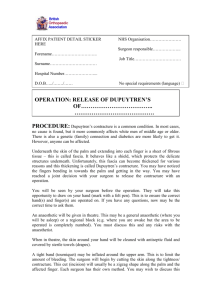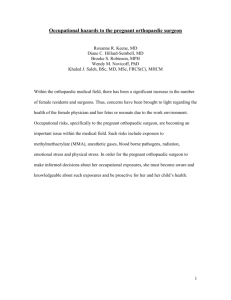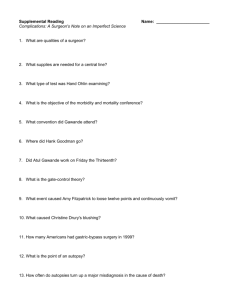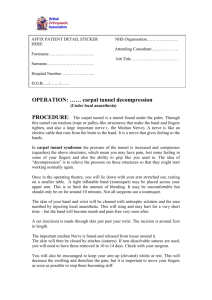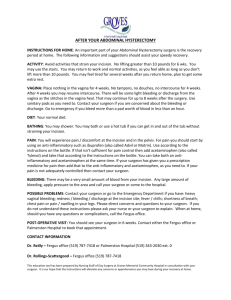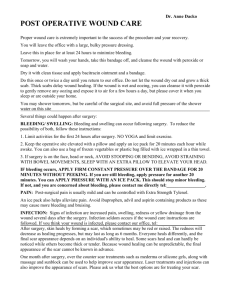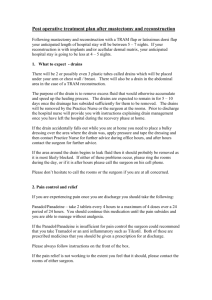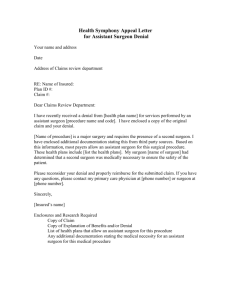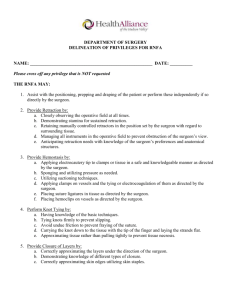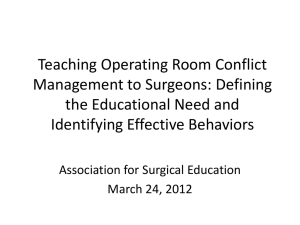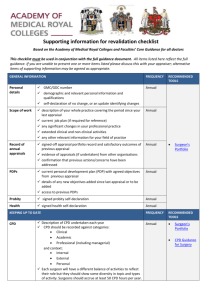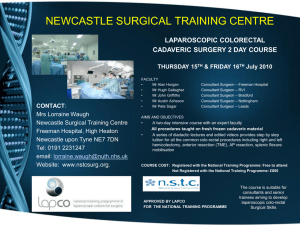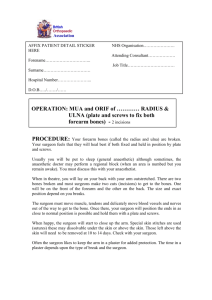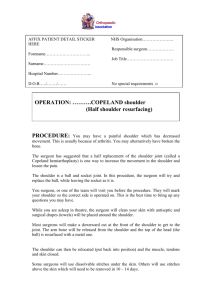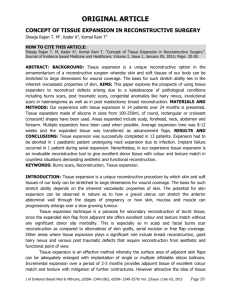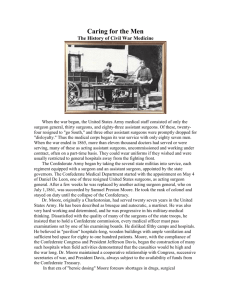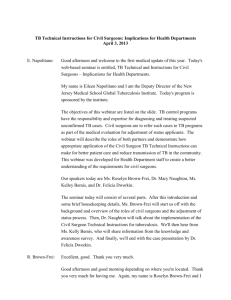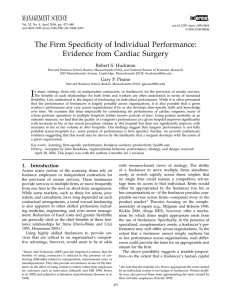British Orthopaedic Association PROCEDURE: The trapezium is one
advertisement
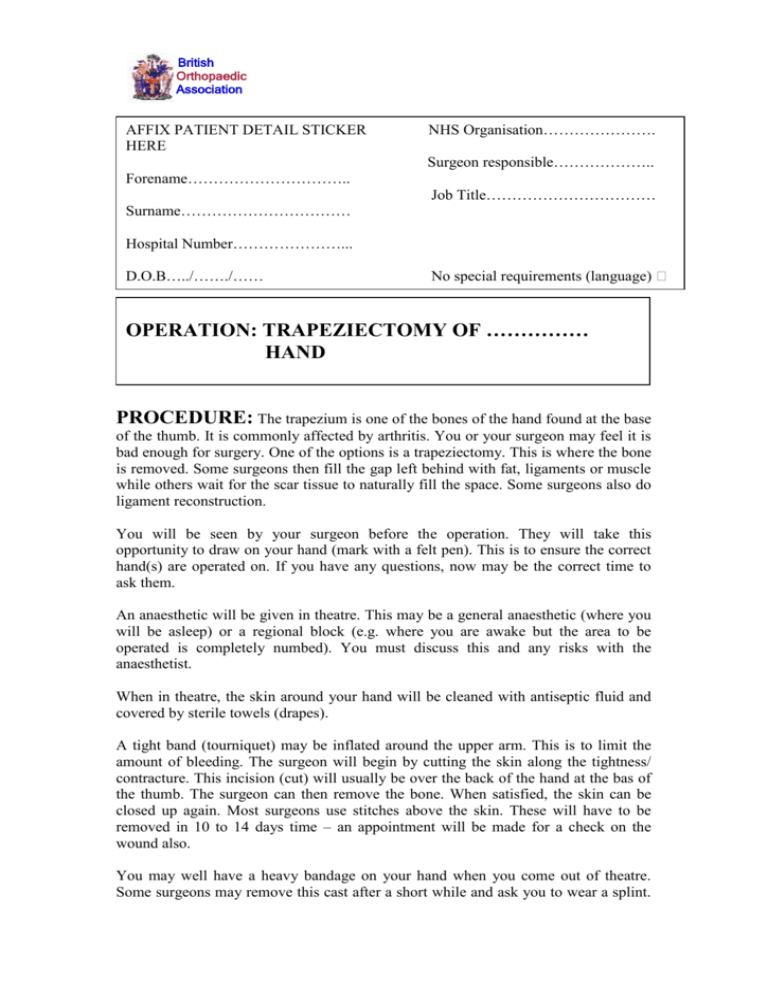
British Orthopaedic Association AFFIX PATIENT DETAIL STICKER HERE NHS Organisation…………………. Surgeon responsible……………….. Forename………………………….. Job Title…………………………… Surname…………………………… Hospital Number…………………... D.O.B…../……./…… No special requirements (language) OPERATION: TRAPEZIECTOMY OF …………… HAND PROCEDURE: The trapezium is one of the bones of the hand found at the base of the thumb. It is commonly affected by arthritis. You or your surgeon may feel it is bad enough for surgery. One of the options is a trapeziectomy. This is where the bone is removed. Some surgeons then fill the gap left behind with fat, ligaments or muscle while others wait for the scar tissue to naturally fill the space. Some surgeons also do ligament reconstruction. You will be seen by your surgeon before the operation. They will take this opportunity to draw on your hand (mark with a felt pen). This is to ensure the correct hand(s) are operated on. If you have any questions, now may be the correct time to ask them. An anaesthetic will be given in theatre. This may be a general anaesthetic (where you will be asleep) or a regional block (e.g. where you are awake but the area to be operated is completely numbed). You must discuss this and any risks with the anaesthetist. When in theatre, the skin around your hand will be cleaned with antiseptic fluid and covered by sterile towels (drapes). A tight band (tourniquet) may be inflated around the upper arm. This is to limit the amount of bleeding. The surgeon will begin by cutting the skin along the tightness/ contracture. This incision (cut) will usually be over the back of the hand at the bas of the thumb. The surgeon can then remove the bone. When satisfied, the skin can be closed up again. Most surgeons use stitches above the skin. These will have to be removed in 10 to 14 days time – an appointment will be made for a check on the wound also. You may well have a heavy bandage on your hand when you come out of theatre. Some surgeons may remove this cast after a short while and ask you to wear a splint. British Orthopaedic Association It is really important you ELEVATE (keep up) your arm to limit the swelling and pain. The scar can be paiful and swollen. Rubbing with simple creams such as E45 will help with this. Full recovery/ function may take many months or may never be achieved, but the pain should be greatly improved. ***Please be aware that a surgeon other than the consultant, but with adequate training or supervision may perform the operation*** ALTERNATIVE PROCEDURE: continued physio/ occupational therapy to increase stretching and splinting (especially at night time) may be useful. Early on the disease, injection of the joints with steroids may also be useful. However, if the disease has progressed, surgery may be the best option. There are many types of surgical procedure that can be done. You should discuss these with your surgeon. These include fusions of the joint. RISKS As with all procedures, this carries some risks and complications. COMMON (1-5%) Pain: the procedure does involve moving soft tissue and will hurt afterwards. It is important to discuss this with the staff and ask for pain killers if needed. The scar itself can be painful. Bleeding: there will inevitably be some bleeding. Do not be alarmed if you see some spotting of blood on the bandage or cast that you leave with. If the bleeding becomes any greater, then you should contact your doctor or nurse. Scar: the operation will leave a thin on the palm and finger. These may be painful. Massaging with moisturiser once the wounds have healed is often helpful at softening them and decreasing the pain. RARE (<1%) Infection: This is may present as redness, discharge or temperature around the wound. A course of antibiotics may be necessary. Thick/ keloid scar: These are scars which grow excessively thick, red and raised. They occur in some people and can not be predicted although if you have a previous keloid scar you are at greater risk. Scars may be treated with steroid injection or surgically if necessary. Delayed wound healing: may occur if the wound is under tension, infected or short of blood supply. Fat necrosis: this is also a cause of delayed wound healing Damage to tendons: these run under the wound and can be cut. CRP syndrome: this is a disorder which usually happens after surgery or other injury. British Orthopaedic Association The skin can become very painful – even to light touch or movement. Numbness: there are important nerves that run along the fingers. These give feeling (sensation). They can be attached to the thickenings or can be damaged during the operation. This may leave you with numbness of the fingers or hand or occasionally some weakness. Neuroma: this is an injury of nerve tissue and can cause numb areas or be painful and sometimes may need to be removed. Confirmation of consent : The doctor has explained the above complications, risks and alternative treatments to me as well as not having the procedure. I hereby give my consent for the above procedure Signature…………………………………………………. Print name……………………………………………………….... Date………./…/20… 2nd Confirmation………………...............…… .Date…………./…..20…. I also give consent for my notes and data to be used in any studies and trials in the future □ signature……………………………………………….. NAME of SURGEON (Capital letters)……………………………….. SIGNATURE of SURGEON…………………………………………. POSITION…………………………………………………………….. DATE……/……/20…..
